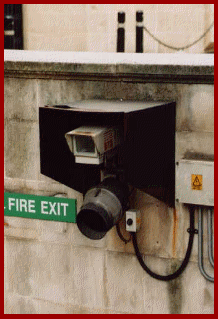| ||||||||||||||||||||||||||||||
Welcome to the | ||||||||||||||||||||||||||||||
 | ||||||||||||||||||||||||||||||
 | ||||||||||||||||||||||||||||||
Making light of a dark place ... | ||||||||||||||||||||||||||||||
Apart from the different IR filter options, which have already been mentioned, there are actually two main types of IR lamp; hot filament Tungsten Halogen and solid state LED. Traditionally a very hot filament lamp, like a cine projector bulb, is used as the light source in an Infra Red illuminator. A thick heat resistant toughened glass filter is placed over the front of the bulb, and so most if not all of the visible light frequencies are filtered out. The other type uses solid state Light Emitting Diodes (LEDs) to generate the Infra Red light at a specific frequency. Whereas with a tungsten based lamp, the light emitted is generally in a wide band which peaks at the filters stated wavelength (e.g. an 830nM filter would probably pass light between 750nM > 880nM); using a solid state LED source means the light is much ‘purer’, so an 850Nm device would most probably emit between 820nM and 880nM. The other major noticeable features of the two types are, weight and heat. Whilst the tungsten models are generally much larger and heavier, they also radiate huge amounts of heat, which is lost to the surrounding air - hence a fairly obvious reason for not placing a lamp directly under the camera housing. (in the photo above, the installers have compounded this problem by placing a metal hood over the camera, so as the heat rises, it generally cooks the camera far more efficiently, and so reduces it's life by years). The three main considerations when using IR lamps is the Infra Red sensitivity of the camera at a specific frequency, the distance that the lamp is intended to illuminate, and the width of beam necessary to light the area covered by the lens. | ||||||||||||||||||||||||||||||
 | ||||||||||||||||||||||||||||||
IMPORTANT: No material may be reproduced, copied or redistributed from this site, © doktorjon.co.uk 2004 - 2008 Homepage...:...Gateway...:...Technical Gateway....:....Quickfind Index....:....Equipment Directory | ||||||||||||||||||||||||||||||

